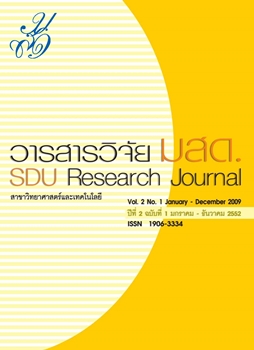การศึกษาคุณลักษณะของปุ๋ยหมักที่ได้จากกากตะกอนของระบบบำบัดน้ำเสีย
Abstract
Abstract
The objectives of this study were to analyze some physical and chemical properties of organic fertilizer based on organic fertilizer properties standards, study factors related to the fertilization process, and study the suitable ratio of organic materials and sludge and the suitable fertilizing period affecting the amount of nutrients in sludge of wastewater treatment system and organic materials used to make the fertilizer.
The research findings showed that six materials were used for making organic fertilizer, namely, sludge from wastewater treatment system, reed (Cyperus polystachyos Roxb.), cattail (Typha angustifolia Linn.), water hyacinth (Eichhornia classipes (Mart.) Solms), rice straw, and fresh garbage. It was found that the majority of materials had properties that met the organic fertilizer properties standards, with the amounts of nutrients such as nitrogen, phosphorus, and especially potassium at the high level. Thus they were suitable as materials for making organic fertilizer. However, the amount of heavy metals, especially that of chromium in the sludge was significantly higher (p<0.05) than that specified in the organic fertilizer properties standards. Also, it was found that the suitable C/N ratio was C/N ratio 25 and the suitable fertilizing duration was 60 days. All six materials could be used in making organic fertilizer to increase the amount of main nutrients, namely, all required nitrogen, all required potassium, all required phosphorus, and the amount of carbon per nitrogen, which were within the Organic Fertilizer Properties Standards, B.E. 2548 of the Department of Agriculture. The best materials for making organic fertilizer were reed (Cyperus polystachyos Roxb.), cattail (Typha angustifolia Linn.) and water hyacinth (Eichhornia crassipes (Mart.) Solms). Before actual utilization of the obtained organic fertilizer, there should be a study to find ways to eliminate the high amount of heavy metals in the fertilizer and to adjust the pH values. The obtained organic fertilizer should be used to plant grasses or decorating plants for the yards, golf courses, and public parks. The contamination of heavy metals in the obtained fertilizer rendered it unsuitable to be used with food plants, even though it contained high amounts of nutrients such as nitrogen, phosphorus and potassium.








